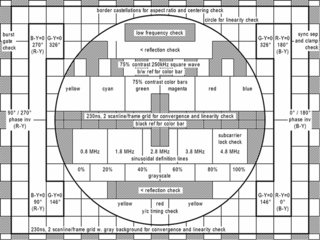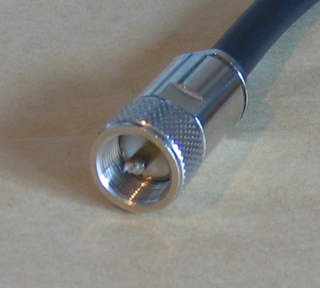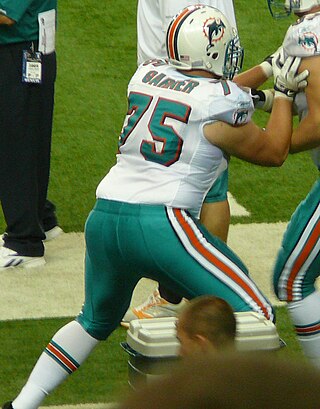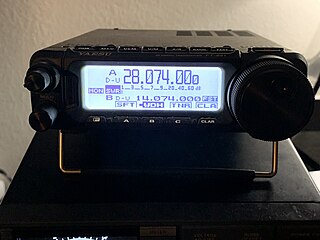Related Research Articles

Very high frequency (VHF) is the ITU designation for the range of radio frequency electromagnetic waves from 30 to 300 megahertz (MHz), with corresponding wavelengths of ten meters to one meter. Frequencies immediately below VHF are denoted high frequency (HF), and the next higher frequencies are known as ultra high frequency (UHF).

Citizens band radio is a land mobile radio system, a system allowing short-distance one-to-many bidirectional voice communication among individuals, using two-way radios operating near 27 MHz in the high frequency or shortwave band. Citizens band is distinct from other personal radio service allocations such as FRS, GMRS, MURS, UHF CB and the Amateur Radio Service. In many countries, CB operation does not require a license, and may be used for business or personal communications.

Ultra high frequency (UHF) is the ITU designation for radio frequencies in the range between 300 megahertz (MHz) and 3 gigahertz (GHz), also known as the decimetre band as the wavelengths range from one meter to one tenth of a meter. Radio waves with frequencies above the UHF band fall into the super-high frequency (SHF) or microwave frequency range. Lower frequency signals fall into the VHF or lower bands. UHF radio waves propagate mainly by line of sight; they are blocked by hills and large buildings although the transmission through building walls is strong enough for indoor reception. They are used for television broadcasting, cell phones, satellite communication including GPS, personal radio services including Wi-Fi and Bluetooth, walkie-talkies, cordless phones, satellite phones, and numerous other applications.

A walkie-talkie, more formally known as a handheld transceiver (HT), is a hand-held, portable, two-way radio transceiver. Its development during the Second World War has been variously credited to Donald Hings, radio engineer Alfred J. Gross, Henryk Magnuski and engineering teams at Motorola. First used for infantry, similar designs were created for field artillery and tank units, and after the war, walkie-talkies spread to public safety and eventually commercial and jobsite work.

Amateur television (ATV) is the transmission of broadcast quality video and audio over the wide range of frequencies of radio waves allocated for radio amateur (Ham) use. ATV is used for non-commercial experimentation, pleasure, and public service events. Ham TV stations were on the air in many cities before commercial television stations came on the air. Various transmission standards are used, these include the broadcast transmission standards of NTSC in North America and Japan, and PAL or SECAM elsewhere, utilizing the full refresh rates of those standards. ATV includes the study of building of such transmitters and receivers, and the study of radio propagation of signals travelling between transmitting and receiving stations.

The 1.25-meter, 220 MHz or 222 MHz band is a portion of the VHF radio spectrum internationally allocated for amateur radio use on a primary basis in ITU Region 2, and it comprises frequencies from 220 MHz to 225 MHz. In the United States and Canada, the band is available on a primary basis from 222 to 225 MHz, with the addition of 219 to 220 MHz on a limited, secondary basis. It is not available for use in ITU Region 1 or ITU Region 3. The license privileges of amateur radio operators include the use of frequencies within this band, which is primarily used for local communications.

The UHF connector is a name for a threaded RF connector. The connector design was invented in the 1930s for use in the radio industry, and is a shielded form of the "banana plug". It is a widely used standard connector for HF transmission lines on full-sized radio equipment, with BNC connectors predominating for smaller, hand-held equipment.
Amateur radio frequency allocation is done by national telecommunication authorities. Globally, the International Telecommunication Union (ITU) oversees how much radio spectrum is set aside for amateur radio transmissions. Individual amateur stations are free to use any frequency within authorized frequency ranges; authorized bands may vary by the class of the station license.

An amateur radio repeater is an electronic device that receives a weak or low-level amateur radio signal and retransmits it at a higher level or higher power, so that the signal can cover longer distances without degradation. Many repeaters are located on hilltops or on tall buildings as the higher location increases their coverage area, sometimes referred to as the radio horizon, or "footprint". Amateur radio repeaters are similar in concept to those used by public safety entities, businesses, government, military, and more. Amateur radio repeaters may even use commercially packaged repeater systems that have been adjusted to operate within amateur radio frequency bands, but more often amateur repeaters are assembled from receivers, transmitters, controllers, power supplies, antennas, and other components, from various sources.
D-STAR is a digital voice and data protocol specification for amateur radio. The system was developed in the late 1990s by the Japan Amateur Radio League and uses minimum-shift keying in its packet-based standard. There are other digital modes that have been adapted for use by amateurs, but D-STAR was the first that was designed specifically for amateur radio.

Clansman is the name of a combat net radio system (CNR) used by the British Army from 1976 to 2010.

Nathaniel W. Garner is a former Division 1 College & NFL professional American football offensive lineman, who mostly played offensive line, especially tackle. Nate began his career with the University of Arkansas Razorbacks of the NCAA just a few years before being drafted by the New York Jets as the seventh round draft pick of the 2008 NFL Draft. Nate was eventually traded to the Miami Dolphins, where he spent the remainder of his professional playing career.

The Yaesu FT-817 is one of the smallest MF/HF/VHF/UHF multimode general-coverage amateur radio transceivers. The set is built by the Japanese Vertex Standard Corporation and is sold under the Yaesu brand. With internal battery pack, on board keyer, its all mode/all band capability and flexible antenna, the set is particularly well suited for portable use. The FT-817 is based on a similar circuit architecture as Yaesu's FT-857 and FT-897, so it is a compromise transceiver and incorporates its features to its low price.
The Yaesu VX series is a line of two sequences of compact amateur radio handheld transceivers produced by Yaesu. There is a line of ultra-compact lower-power dual-band transceivers that started with the VX-1R and was later updated with the VX-2R and VX-3R. There is also a line of 5W tri-band transceivers that started with the VX-5R and was later updated with the VX-6R, VX-7R and VX-8R.

A personal radio service is any system that allows individual to operate radio transmitters and receivers for personal purposes with minimal or no special license or individual authorization. Personal radio services exist around the world and typically use light-weight walkie talkie portable radios. The power output, antenna size, and technical characteristics of the equipment are set by regulations in each country. Many regions have standardized personal radio service rules to allow travelers from one country to use their equipment in another country. Examples of standardized services include PMR446 and FM Citizens Band Radio (CB) in the EU and several other countries/regions. 26–27 MHz CB radio is the oldest personal radio service and is used in nearly every country worldwide, with many countries and regions copying the United States 40-channel frequency plan. In many countries, CB radio is less popular due to the availability of other personal radio services that offer shorter antennas, better protection from noise and interference.

The Yaesu FT-891 is a HF and 6 meters all mode mobile amateur radio transceiver. The FT-891 was first announced to the public by Yaesu at the 2016 Dayton Hamvention. The radio has 100 watts output on CW, SSB, and FM modulations and 25 watts of output in AM. As a mobile transceiver the FT-891 is well suited for mobile installation in vehicles, and weighing less than 5 pounds it is often used for field activations such as Summits On The Air and Parks On The Air. The radio has been praised for its noise reduction and sensitive receiver. Common criticisms of the radio include its many menus that are difficult to navigate with its small screen, the lack of VHF/UHF capabilities, and lack of an internal antenna tuner. Although the radio lacks an internal sound card it still has input and output jacks for audio and be controlled over a USB cable allowing the radio to use digital modes such as WinLink, PSK31 and FT8.

The ICOM IC-705 is a multimode HF/VHF/UHF portable amateur radio transceiver. The radio has 5 watts of output when using its internal battery and 10 watts of output when using external power. With the rise in award programs such as Summits on the Air, and Parks on the Air this lightweight fully functional radio is a popular choice for people using them in the field. The IC-705 has support for a wide variety of commonly used amateur radio modes including ICOM's proprietary digital voice mode D-STAR. The IC-705 is also one of the first mainstream amateur radios to use SDR technology instead of the older superheterodyne design. Additionally the IC-705 has multiple extra features that are useful when operating in the field. Supporting the radio's D-STAR module is a GPS receiver to allow users to send their location though the D-STAR network as well as help locate nearby repeater systems. In addition to the GPS receiver the radio supports 2.4 GHz Wi-Fi which allows users to connect their computers or tablets to the IC-705 for running digital data modes such as PSK31, Winlink, and FT8. The radio has been praised for its size, easy to use menus, large easy to read screen and the quality of its build. Common criticisms of the radio include its lack of a built in antenna tuner and its price compared to other more powerful radios on the market.

The ICOM IC-7300 is a multimode 6 meter, 4 meter and HF base station amateur radio transceiver. The IC-7300 was announced to the public at the Japan Ham Fair in 2015. The radio has 100 watts output on CW, SSB, and FM modulations and 25 watts of output in AM. Although not the first software-defined radio on the market, the IC-7300 was the first mass-produced mainstream amateur radio to use technology instead of the older superheterodyne transceiver design. Designed to replace the older IC-746PRO the IC-7300 is smaller and significantly lighter than its predecessor. Like many other radios of its class the IC-7300 has an internal antenna tuner and contains an internal audio card accessible over USB. This allows the radio to be used for popular digital modes such as PSK31, Winlink, and FT8. The radio has received praise for its easy to use menus, large readable screen, and excellent audio processing.
The ICOM IC-7100 is a multimode HF/VHF/UHF mobile amateur radio transceiver. The IC-7100 has support for a wide variety of commonly used amateur radio modes including ICOMs proprietary digital voice mode DSTAR. Additionally the radio offers 100 watts on HF, 50 watts on VHF, and 35 watts on UHF. The IC-7100 is unique in that it has a large detachable control head with a slanted display so the transmitter can be installed elsewhere in a vehicle or home. The receiver used in the IC-7100 is a triple conversion superheterodyne and has excellent DSP and audio filters. The IC-7100 allows for connection to a computer over USB which enables the radio to be used for popular digital modes such as FT8, Winlink, and Packet Operation. Locations of nearby repeaters and sending APRS locations can be done with an optional GPS receiver attachment. Notable features that the IC-7100 lacks is an internal antenna tuner.
References
- 1 2 "Icom IC-905 VHF/UHF/SHF Transceiver Announced at Tokyo Hamfair 2022 – News – Icom UK". icomuk.co.uk. Retrieved 23 August 2022.
- ↑ "New ICOM IC-905 VHF/UHF/uW transceiver | Southgate Amateur Radio News". www.southgatearc.org. Retrieved 23 August 2022.
- 1 2 DXZone (20 August 2022). "Introducing IC-905 first VHF/UHF/SHF Transceiver". The DXZone. Retrieved 23 August 2022.
- 1 2 NEW Radio! ICOM IC-905 Announcement Live React With Ray Novak , retrieved 23 August 2022
- ↑ See http://www2.rfsworld.com/RFS_Edition4/pdfs/TechInfo_Edition4_639-672.pdf Archived 12 July 2018 at the Wayback Machine , p. 644
- ↑ "icom IC-905 VHF UHF SHF 무전기 새로운 점과 특징". IT블로거 도여니 (in Korean). 21 August 2022. Retrieved 23 August 2022.
- 1 2 McColm, Andrew (21 August 2022). "The new IC-905 VHF to 10 GHz amateur radio". VK3FS. Retrieved 23 August 2022.
